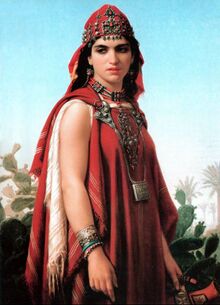Kaharna
This article is incomplete because it is pending further input from participants, or it is a work-in-progress by one author. Please comment on this article's talk page to share your input, comments and questions. Note: To contribute to this article, you may need to seek help from the author(s) of this page. |
| Kaharna | |
|---|---|
 | |
| Tamenokalt | |
| Reign | 5th century BCE |
Kaharna, alternatively known as Kahr Anan, was a 5th century BCE Amazigh queen who is believed to have ruled an ancient confederation of the Amazigh peoples stretching across large areas of central and northern Scipia and the Periclean coast. Kaharna is sometimes referred to as the Great Mother or Mother of us all and is revered by many extant groups of Amazigh decent, particularly those adherent to the Kaharnist tradition of Charnea and the Ninva desert. These Kaharnists deify the figure of Queen Kaharna as their spiritual matron and divine forbearer, while other groups instead revere her as one legendary ancestor among others.
Queen of the Amazigh
Reign and Legends
Tomb
For most of recorded history, it was believed that Kaharna had been cremated and scattered into the Ninva desert, a belief reinforced by many of the oral histories of Kaharnist traditions of northern Charnea. While this type of burial was typically something reserved for lower status individuals or criminals in Tamashek society, it was believed that Kaharna had wished to be so treated so that her spirit would join with the sands of the desert and become one with the lands of her people. This version was challenged when in 1923 what is widely believed to be the genuine tomb of the historical Queen Kaharna was found in the Thumer Hills in northwestern Charnea, less than 200 kilometers from the border with the Messidor Union. Numerous objects were found in the ziggurat-like structure uncovered at the Thumer site, in addition to inscriptions and secondary burials all of which support the theory that the skeletal remains discovered in the main burial chamber may indeed belong the legendary Queen of the ancient Amazigh peoples who has since become a divine figure to many of her descendants. While many Kaharnist adherents continue to reject the academic evidence, many more Kaharnist communities have welcomed the discovery of the site, altering their traditions accordingly and in 1955 petitioning the Charnean government to recognize the archeological site as a religious holy site for those of their faith in addition to its previously held status as a cultural heritage site. This motion would be accepted in 1956, beginning a pattern of pilgrimages to the isolated site by the faithful. Requests to fully convert the site into an active Kaharnist ancestor shrine were denied however, on the basis that this would cause undue disruption to the delicate ruins and possibly damage or cover up features of potential historical significance.
The mausoleum is built in the style of contemporary tomb-temples of many Amazigh chieftains, with a tumulus shape to its stone structure which had appeared as a sand-covered hill prior to its excavation. It bears many similarities to the monumental tomb complexes of much later historical figures such as the Great Pyramid of Agnan, which itself is extremely similar to the Thumber structure save for its outward appearance as a terraced pyramidal megalith as opposed to a low conical form. The remains of an ancient stelae field surrounding the central tumulus has also been found, mirroring the layout of holy sites and ancestor shrines maintained by Kaharnist nomads of northern Charnea. These discoveries strongly suggested that the Thumer site was of ongoing significance to the contemporary peoples of the region, which are theorized to have practiced a precursor to the modern ancestor worship practices of many Amazigh groups. It is likely that Kaharna's tomb at the Thumer Hills mausoleum remained a site of religious and political importance, where the queen's successors and subjects came to confer with her spirit at her grave site. The prevailing supposition holds that the location of the tomb was lost during or immediately following the dissolution of Kaharna's ancient Amazigh confederation, and was subsequently forgotten by the descendants of that polity leading to the creation of myths such as the Charnean oral tradition account of her cremation and scattering into the desert.